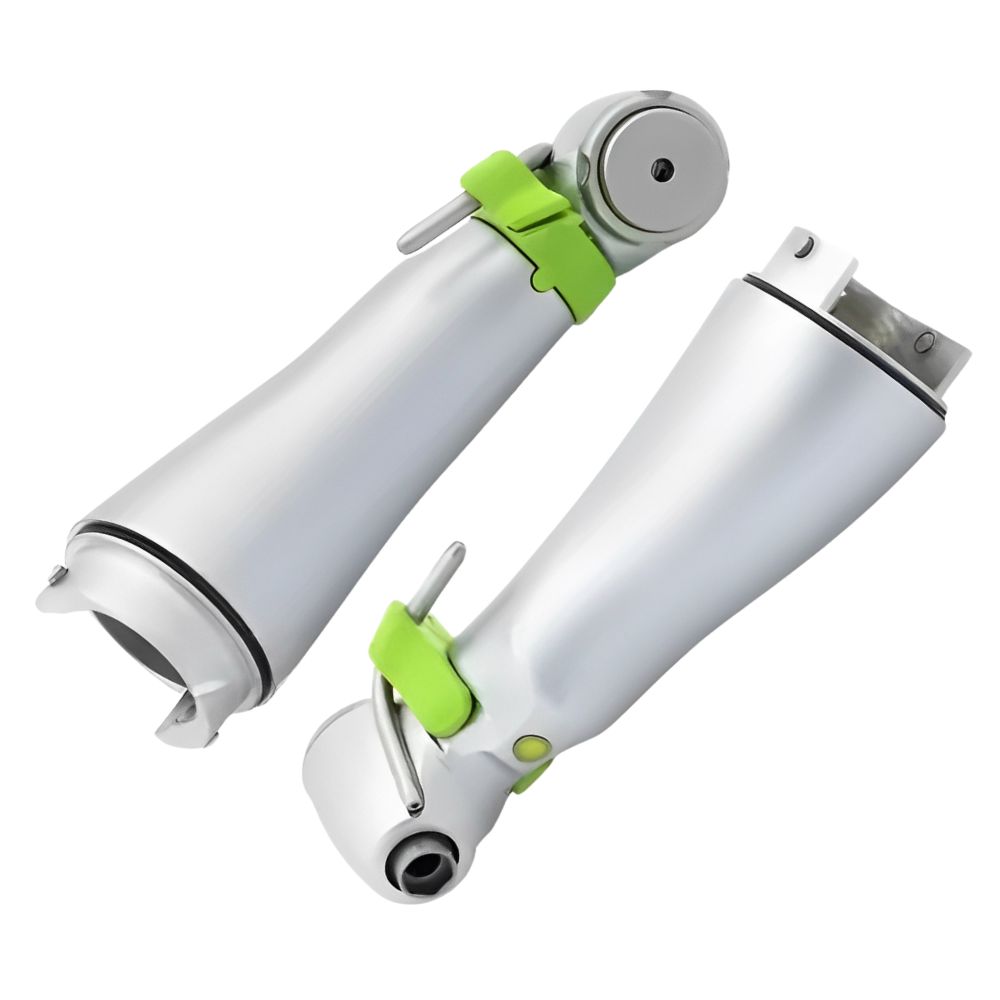A Comprehensive Guide to Choosing Dental Handpieces for Different Specialties
What are the types of handpieces?
Guide to Choosing Dental Handpieces for Different Specialties

Guide to Choosing Dental Handpieces for Different Specialties
This guide examines the selection criteria for dental handpieces based on professional specialization, integrating the technical perspective of manufacturers with daily clinical requirements. We will analyze fundamental parameters and then classify handpieces by area of specialization.
Fundamental Technical Differentiations
Dental handpieces are divided into two primary categories:
Turbine handpieces: Operate using compressed air supplied from a compressor through a dedicated hose. These require a specific adapter (quick-connect coupling). When selecting a turbine handpiece, it is essential to specify the connection type: the number of channels and whether it includes a light source. Here you can find spare parts for Turbine Handpieces
Mechanical handpieces: Powered by a motor (pneumatic or electric), they connect to the dental unit through a shaft rotation transmission system. Buy Here High Quality Compatible Parts for Contran Angle Handpieces
Speed Parameters
High-speed models are primarily turbine handpieces. It is important to note that turbine handpieces do not maintain constant speed during contact with hard tissues, experiencing performance reduction proportional to applied pressure. With lateral pressure, the reduction can exceed 50% of nominal speed.
Speed-increasing handpieces, powered by motors that are more difficult to slow down, offer more stable preparation performance.
Angled handpieces feature color-coded markings to identify their speed characteristics:
- Red: 1:5 Speed-increasing
- Blue: 1:1 ratio
- Green: Speed-reducing
- Yellow: Special movements
How to calculate the speed of a speed-increasing handpiece with a 1:5 transmission: In fact is very easy, you need to multiply the motor speed (which maximum is 40 000 rotations per minute) by 5. For optimal performance, using these handpieces with an electric micromotor (capable of 40,000 RPM) can achieve up to 200,000 RPM with a 1:5 transmission.
Speed-reducing handpieces operate inversely. For example, a handpiece with a 7.4:1 reduction ratio will reduce a 40,000 RPM motor speed to 5,405 RPM at the bur.
Some complex handpieces consist of body and head components, each with individual reduction ratios that multiply for total reduction.
Speed-reducing handpieces offer higher torque, making them ideal for polishing, hygiene, and therapeutic procedures.
Critical Technical Features
Noise Levels: Professional-grade handpieces operate between 50-70 dB. Models at approximately 57 dB offer optimal comfort for both clinician and patient. Comparative assessment can be performed using smartphone sound meter applications under controlled conditions.
Power: Measured in watts (W), this parameter indicates tissue removal capacity per time unit. Lower power necessitates increased pressure, potentially damaging the handpiece. Turbine handpiece power depends on rotor group design and air pressure. Premium models range from 18-20 W.
Illumination: Integrated illumination systems supplement the dental unit’s lighting. Options include built-in generators or light guide systems. LED technology now represents the clinical standard, offering high-intensity, neutral-temperature illumination that reduces visual fatigue.
Spray Systems: Most advanced handpieces incorporate spray systems for bur cooling and preparation site irrigation. Optimal designs feature 3-4 spray points, ensuring adequate water distribution. Non-spray models remain suitable for brief procedures with minimal thermal risk.
Specialty-Specific Selection Criteria
Prosthodontists: High-speed handpieces optimize prosthodontic procedures involving substantial tissue volumes. Models with speeds of 200,000+ RPM are recommended. Powder-jet instrumentation provides precision for microtexture creation. Ensure adjustable powder delivery systems with simplified maintenance protocols.
General Dentists: For caries preparation, angled handpieces with 1:1 transmissions and speed-reducing models are standard. Speed-reducing handpieces excel in low-speed applications such as cavity floor preparation, while turbine handpieces facilitate efficient, larger-scale caries removal.
Endodontists: Specialized endodontic handpieces designed for dedicated endodontic motors represent the gold standard. Alternatively, speed-reducing handpieces with specialized heads accommodating various file diameters may be utilized. Endodontic motors remain the optimal choice for safety and precision.
Oral Surgeons Handpieces: In Implantology, you need speed-reducing handpieces with 20:1 transmission, as implant placement demands precise low speeds (maximum 50 RPM). Surgical turbines with 45-degree angled heads facilitate access to distal regions. These specialized turbines incorporate air venting systems, preventing embolism risk.
For Dental Hygienists: Hygienists in their professional cleaning and polishing need 1:1 which means that maximum speed will obtain 40 000 rpm or speed-reducing handpieces are indicated. Hygiene-specific handpieces operating at approximately 5,000 RPM with 70-degree reciprocating movements prevent material dispersion and protect mechanical components from contamination.
Conclusion
Selecting the appropriate dental handpiece is fundamental for treatment efficacy and efficiency.
Hope in this article was clearly explained what are the types of handpieces and key technical parameters and matching them to your clinical specialty enhances treatment outcomes and patient satisfaction. Whether practicing prosthodontics, general dentistry, endodontics, oral surgery, or dental hygiene, purpose-designed handpieces exist to meet specific requirements. Always evaluate speed capabilities, power output, acoustic properties, and illumination systems when selecting instruments for your clinical practice.
Written by Eugeniu Saca
F.A.Q.
Turbine handpieces operate at higher initial speeds but experience significant speed reduction during tissue contact, sometimes exceeding 50% of nominal speed. Mechanical handpieces, particularly those with electric micromotors, maintain more consistent operational speeds and offer superior torque stability during procedural applications.
The color-coding system provides immediate visual identification of transmission ratios:
- Red markings: 1:5 speed-increasing transmission
- Blue markings: 1:1 direct transmission
- Green markings: Speed-reducing transmission
- Yellow markings: Specialized movement mechanisms
For speed-increasing handpieces (e.g., 1:5 ratio), multiply the motor speed by the ratio (e.g., 40,000 RPM × 5 = 200,000 RPM). For speed-reducing handpieces (e.g., 7.4:1 ratio), divide the motor speed by the ratio (e.g., 40,000 RPM ÷ 7.4 = 5,405 RPM).
Professional-grade handpieces operate between 50-70 dB. Instruments producing approximately 57 dB represent the optimal balance between operational efficiency and acoustic comfort for both practitioner and patient.









